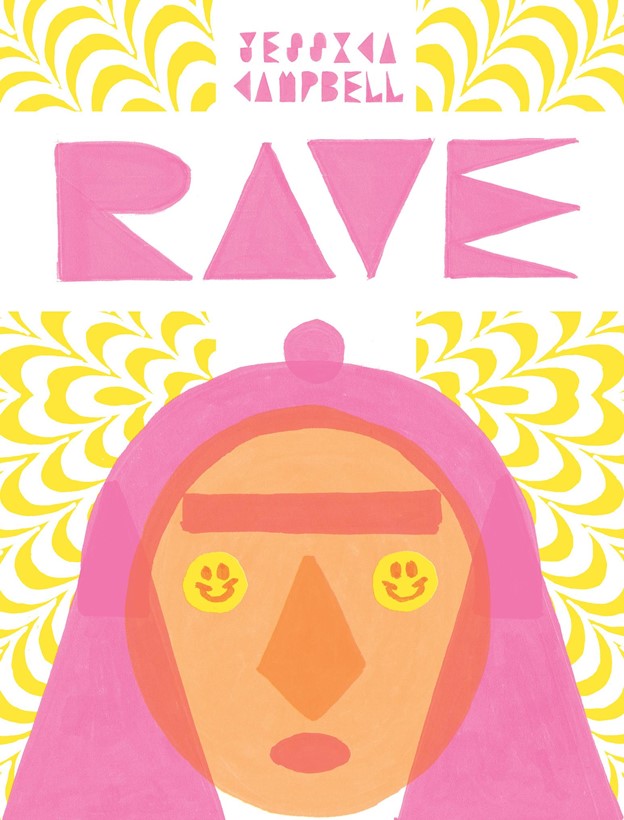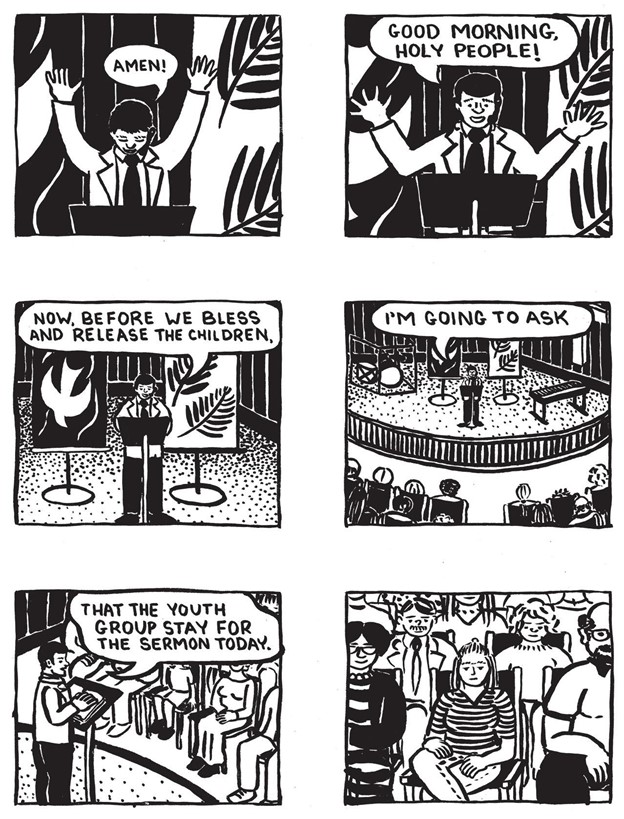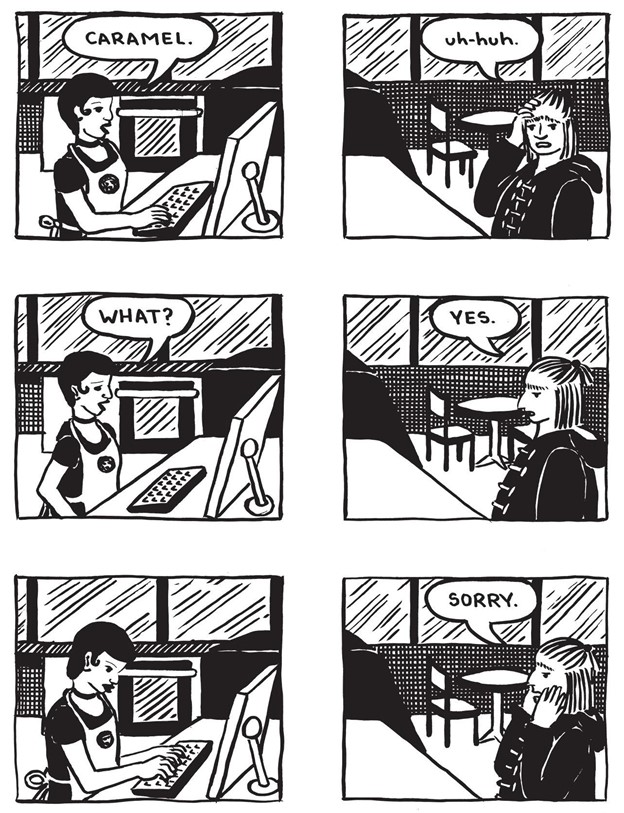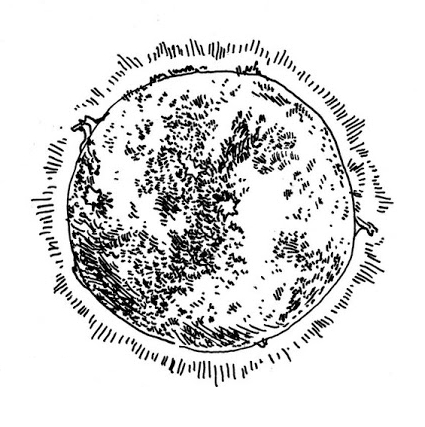
What happens when an evangelical church becomes a main character in a graphic novel? You get a quietly simmering tale of what happens when teens begin to question the space it consumes in their lives. Rave, Jessica Campbell’s first fictional graphic novel, explores one young woman’s relationship with the church as she embarks on her first lesbian love affair. Campbell’s first foray into comics, Hot or Not: 20th Century Male Artists (2016), lampoons our culture’s obsession with looks. This time, Campbell tackles the (conservative Christian) church, with some of that same humor, but much more anger. While Campbell may be better known for her fiber paintings and sculpture (such as the psychedelic La-Z-Boy covered in neon green car wash mitt material), her new graphic novel tackles what she refers to as “the cycles of violence and repression” within some conservative, evangelical communities. To capture the hypocrisy Campbell herself experienced as a teenager growing up in a conservative church, she turned to fiction to incorporate her friends’ experiences, news stories, and more.
As soon as readers open to the first page, it’s evident what the story’s central force is: the cross and all its trappings draw attention like a bullseye. And, we enter those eaves to watch a pastor discuss “sexual urges!…Impure thoughts” and how to fight them. We see our main human character, Lauren, as a passive receiver of the pastor’s sermon. In chunky black and white drawings, Campbell takes readers back to the late 1990s and what it’s like to be an unsure teenager. During the pastor’s discussion of resisting sexual temptation, he humiliates his own teenage daughter, who is pregnant and unwed. She is also a classmate of Lauren’s, but what Lauren makes of this theater is unclear.


Lauren is a timid character; her insecurity coupled with Campbell’s cinematic approach to storytelling makes Lauren come across as a mere observer to her own life. Without exposition or access to Lauren’s inner thoughts, the audience is often left to interpret how she must feel about a situation by trying to read her inscrutable expression or through a quip in the dialogue. We can tell she feels some horror when Lauren is paired with a freethinking “Wiccan” student named Mariah for a science project on evolution. An unlikely friendship ensues and progresses into a romantic relationship.
Campbell uses the six-panel-per-page “waffle grid” layout–one common with graphic memoirs–to lend authenticity to her coming-of-age and coming-out story. When she does step out of the six-panel grid, the results are satisfying, particularly when Campbell devotes a full page to establishing a new setting. On page 58, the audience gets to see Mariah’s room through Lauren’s eyes: messy, with a Wiccan altar by the bed. Although the reader can see she is unnerved by the altar (with the quintessential knife, candles, tasseled tablecloth, and vaguely witchy objects), she reveals none of this uneasiness to Mariah, instead choosing to take a chance on the blossoming relationship.
In a deft comics move, Campbell shows the passage of time and deepening familiarity between the two by repeating panels showing Lauren giddily chatting into the landline. While the rotary dial phone and chair remain in the same position in each panel, Lauren changes outfits and sitting positions to show that days–or possibly weeks–are flying by while the two girls talk. We also get a montage of moments from the evolving relationship; a glimpse of a snowball fight, going to an art museum, and making out all indicate growing closeness. But romantic montages can’t last forever, and Lauren finds herself back in the pews.

Although set in the 90s, RAVE is coming out in a moment when both comics and LGBTQ+ communities are threatened by legislation. With more than 50 bills aiming to ban teaching topics across the country and the unprecedented, whopping 729 book challenges reported to the American Library Association last year (seeking to remove some 1597 individual titles), more and more graphic novels are being removed from the shelves. According to the New York Times, the graphic memoir Gender Queer by Maia Kobabe was the most challenged book in 2021–due to “the memoir’s frank discussion of gender fluidity.” Meanwhile, Florida Governor Ron DeSantis has recently signed the “Parental Rights in Education” bill, which prohibits classroom instruction and discussion of sexual orientation and identity in elementary school. From political pressure to threats of criminal charges against library employees to death threats sent to authors, comics like RAVE face amplified public spectacle and potential prohibition–even as they are most needed to provide people with a path to break out of these cycles of violence and repression that Campbell addresses.
In RAVE, we see various church figures warn against sin, but, in Campbell’s hands, the church itself becomes the thing to be warned about–insidious, harmful, immoral. Not only are Lauren and Mariah harmed by what the pastors and religious society think, so too are minor characters. One church friend can’t participate in the evolution project in school at all, another boy at church already can’t wait to “get married as soon as possible and have a kid every nine months.” Campbell effectively shows how the roots of the ugly, extremist policies have been in existence long before our current polarization, through the tentacles of Quotidien Sunday mornings in so many lives, not planned movements.

No one knows where these book challenges and laws will lead or which books will be threatened next, but perhaps we can take a bit of solace from RAVE: Lauren refuses to listen to the rest of a sermon, leaves the church, and lights up a cigarette in the parking lot, gazing out, making her first step into rebellious territory.
SOLRAD is made possible by the generous donations of readers like you. Support our Patreon campaign, or make a tax-deductible donation to our publisher, Fieldmouse Press, today.

Leave a Reply